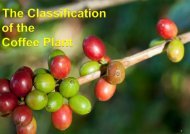Create successful ePaper yourself
Turn your PDF publications into a flip-book with our unique Google optimized e-Paper software.
Until <strong>the</strong> 1940s, <strong>the</strong> majority <strong>of</strong> c<strong>of</strong>fee <strong>plant</strong>ations in Central America were <strong>plant</strong>ed with Typica. But because <strong>of</strong><br />
its low yield and high susceptibility to c<strong>of</strong>fee diseases, it has gradually been replaced. Today, c<strong>of</strong>fee production<br />
in Latin America is still based to a large extent on cultivars developed from Typica or Bourbon and varieties<br />
<strong>the</strong>re<strong>of</strong>. In Brazil over 95 % <strong>of</strong> c<strong>of</strong>fee cultivars are derived from Typica and Bourbon varieties. However, <strong>the</strong><br />
wide use <strong>of</strong> pesticides enables c<strong>of</strong>fee growers with intensive agriculture to maintain <strong>the</strong>se varieties in <strong>the</strong>ir<br />
<strong>plant</strong>ation, despite <strong>the</strong>ir susceptibility to diseases.<br />
Bourbon: The first Bourbon <strong>plant</strong>ation dates back to <strong>the</strong> early 18 th century after it was introduced on ile<br />
Bourbon (an island east <strong>of</strong> Madagascar in <strong>the</strong> Indian Ocean, now known as La Reunion) from Yemen. It is still<br />
cultivated in Africa and e.g. Guatemala and known for its high cup quality. Bourbon goes back to a broad group<br />
<strong>of</strong> C. arabica specimen that developed naturally. Depending on <strong>the</strong> specific sub-group, this c<strong>of</strong>fee can be red<br />
or yellow. These <strong>plant</strong>s generally have broader leaves and rounder fruit and seeds than Typica. Sterns are<br />
stronger and stand more upright than Typica. They can show very good quality but are susceptible to all major<br />
diseases and pests.<br />
Typica: This varietal name is commonly used for numerous tall types <strong>of</strong> C<strong>of</strong>fea arabica and <strong>the</strong> most prominent<br />
trait are <strong>the</strong> bronze-tipped young leaves. lts predecessors were originally brought to Java from Yemen<br />
(possibly via lndia) and also to Europe in <strong>the</strong> beginning <strong>of</strong> <strong>the</strong> 18 th century, from where Typica was spread all<br />
over <strong>the</strong> world. Typica <strong>plant</strong>s are known to have low productivity and <strong>the</strong>y are susceptible to all main c<strong>of</strong>fee<br />
pests and diseases. Typica c<strong>of</strong>fees include Blue Mountain, Guatemala, Sumatra, Pache, Java, and Kona. T<br />
37








